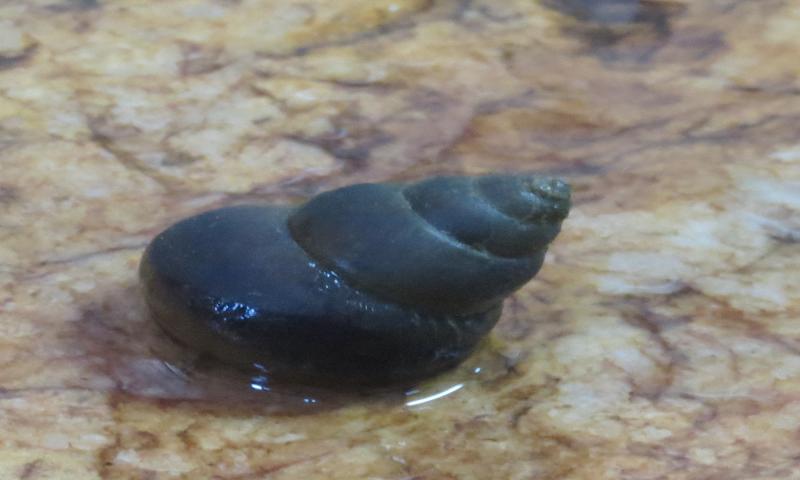
Mud snails, also known as mystery snails, live in freshwater and belong to a snail family called Viviparidae. They are found throughout the world except in South America and Antarctica. Such globally distributed species incite interesting questions about their dispersal across different continents.
In a recent study, researchers in Bengaluru from the Ashoka Trust for Research in Ecology and the Environment (ATREE) and the Indian Institute of Science (IISc), investigated manifestation of these mystery snails in India. The study, published in the journal Molecular Phylogenetics and Evolution, was funded by the Department of Biotechnology (DBT), Department of Science and Technology (DST), Scientific Research and Engineering Board, Rufford Small Grant for Nature Conservation, and the Institute of Bioresource and Sustainable Development.
The mystery snails found in India belong to a subfamily known as Bellamyinae and are distributed throughout the Indian subregion. This distribution suggests that either mystery snails diversified from a common ancestral species from India or there could have been multiple dispersal events from outside into India. The latter theory, called 'into-India' dispersal, in general, emphasizes the movement of flora and fauna from adjoining land masses during the collision of the Indian and Asian plates millions of years ago.
The researchers extracted and sequenced DNA from 24 snails captured from different parts of India including Maharashtra, Karnataka, Uttar Pradesh and various regions in northeast India. They also obtained genetic data of Bellamyinae — from Asia, Africa and Australia, and related subfamilies — Viviparinae and Lioplacinae — from Europe and North America respectively from GenBank, an open-access genetic sequence database. This inclusion of sequences from different countries is essential as it provides a global perspective of species diversity and inter-group relationships. The researchers then compared the obtained mitochondrial DNA and nuclear DNA sequences to determine evolutionary relationships among these snails.

A typical habitat - Lakhimpur-Kheri, Uttar Pradesh, India. Photo credit- Maitreya Sil
A technique called molecular dating helps to estimate the rate of changes in genetic sequences during evolution over time. Researchers used this technique to determine when and where the different species of mystery snails considered in the study originated and evolved. They also studied prevalent climatic conditions during the diversification of mystery snails.
"Molecular dating enables us to know exactly when a lineage split happened. Along with ancestral range estimation, it tells you the time of dispersal," explains Dr Maitreya Sil, the lead author of the study. "Once you know that, you can investigate whether the dispersal events are concurrent with any geological or climatic events."
As mystery snails are freshwater snails, marine barriers between the landmasses can be a significant barrier for dispersal. Besides, the dispersal rates vary with fluctuations in climate, since mystery snails prefer a warm and humid environment. Researchers use this knowledge to figure out when dispersals would have taken place during various climatic and geological events and if the snail diversity is consistent with specific paleogeographic events or climatic conditions.
“Freshwater organisms have low or no salinity tolerance. Hence, when they disperse from one continent to another, they require some terrestrial connection between those landmasses," says Dr Sil. "Freshwater snails are interesting because they do seem to be dispersed by aquatic birds, which means none of these assumptions might work."
The current study suggests that two significant events occurred for the dispersal of Bellamyinae into India. The first happened when the two landmasses of Indian subregion and South-East Asia had not yet combined, and the climate was warmer and humid. The second occurred during drier climatic conditions after the landmasses had sutured together. The study also explored whether periodic retreating of seawater, called marine transgressions, between the landmasses played any role in the dispersal of mystery snails but could not find any link between the two.
The lack of fossils from specific geological epochs, which are vital to understand dispersal, was a challenge.
"I had to carry out an intensive literature review to find suitable fossils and decide on the prior distribution for calibrating the phylogeny. Besides, the taxonomy of these groups is outdated, so we carried out species delimitation based on molecular data," recalls Dr Sil.
Species delimitation refers to inferring out biological diversity at the species level by outlining boundaries of definition for a given species. It aids in providing a stronger and clearer idea of dispersal events.
Previous studies that attempted to determine the evolution of mystery snails rendered an incomplete picture of dispersal events. Therefore, this study, employing multiple techniques that include phylogenetics, molecular dating and ancestral range estimation with a large scale sampling, is insightful. Since several climatic and geological factors influence the dispersal of any species, relevance to the ecology and evolution of the species throws more light onto biogeographic investigations.
While the study did not focus on the effect of climate change on dispersal, it provides insights into how the changing climate can mediate major dispersal events. In the case of mystery snails, one can speculate that changing physical characteristics of freshwater sources can lead to a decrease in suitable habitats.
"Our study supports that one dispersal took place during the humid climatic period. Hence, these snails might face habitat fragmentation if aridification is caused by climate change," concludes Dr Sil.
This article has been run past the researchers, whose work is covered, to ensure accuracy.






